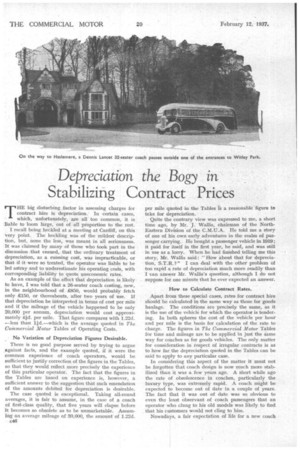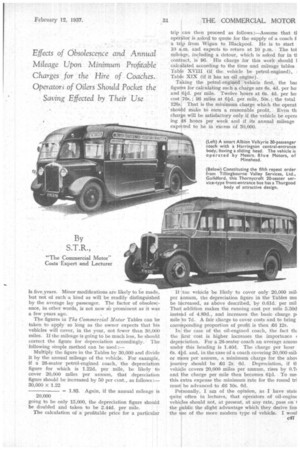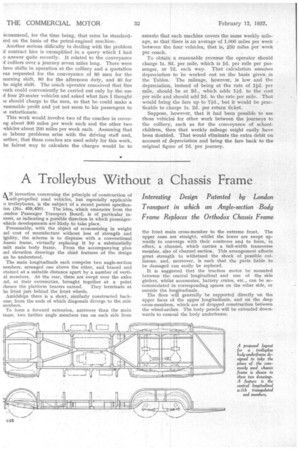Depreciation the Bogy• in Stabilizing Contract Prices
Page 96

Page 97

Page 98

If you've noticed an error in this article please click here to report it so we can fix it.
Effects of Obsolescence and Annual Mileage Upon Minimum i Profitable Charges for the Hire of. Coaches. Operators of Oilers Should Pocket the
Saving Effected by Their Use By S.T.R.,
"The Commercial Motor" Costs Expert and Lecturer THE big disturbing factor in assessing charges for contract hire is depreciation.In certain cases, which, unfortunately, are all too common, it is liable to loom large, out of all proportion to the rest.
I recall being heckled at a meeting at Cardiff, on this very point. The heckling was of the mildest description, but, none the less, was meant in all seriousness. It was claimed by many of those who took part in the discussion that ensued, that the ordinary treatment of depreciation, as a running cost, was impracticable, or that if -it were so treated, the operator was liable to be led astray and to underestimate his operating costs, with corresponding liability to quote uneconomic rates.
As an example of the effect that depreciation is likely to have, I was told that a 26-seater coach costing, new, in the neighbourhood of £850, would probably fetch only £150, or thereabouts, after two years of use. If that depreciation be interpreted in terms of cost per mile and if the mileage of the vehicle happened to be only 20,000 per annum, depreciation would cost approximately lid. per mile. That figure compares with 1.22d. —less than 11d.—which is the average quoted in The Coin mercial Motor Tables of Operating Costs.
.. No Variation of Depreciation Figures Desirable.
There is no good purpose served by trying to argue .against facts, and the example quoted, if it were the common experience of coach operators, would be sufficient to justify correction of the figures in the Tables, so that they would reflect more precisely the experience of this particular operator. The fact that the figures in the Tables are based on experience is, however, a sufficient answer to the suggestion that such emendation of the amounts debited for depreciation is desirable.
The case quoted is exceptional. Taking all-round averages, it is fair to assume, in the caseof a coach of first-class quality, that five years will elapse before it becomes so obsolete as to be unmarketable. Assurnin,g an average mileage of 30,000, the amount of 1.22d.
c46 per mile quoted in the Tables is a reasonable figure to take for depreciation.
Quite the contrary view was expressed to me, a short time ago, by Mr. J. Wallis, chairman of the NorthEastern Division of the C.M.U.A. He told me a story of one of his own early adventures in the realm of passenger carrying. He bought a passenger vehicle in 1919; it paid for itself in the first year, be said, and was still in use as a lorry. When he had finished telling me this story, Mr. Wallis said : "How about that for depreciation, S.T.R.?" I can deal with the other problem of too rapid a rate of depreciation much more readily than I can answer Mr. Wallis's question, although I do not suppose for one minute that he ever expected an answer.
How to Calculate Contract Rates.
Apart from these special cases, rates for contract hire should be calculated in the same way as those for goods haulage. The conditions are precisely the same, as it is the use of the vehicle for which the operator is tendering. In both spheres the cost of the vehicle per hour and per mile is the basis for calculation of the rate to charge. The figures in The Commercial Motor Tables for time and mileage are to be applied in just the Same way for coaches as for goods vehicles. The only matter for consideration in respect of irregular contracts is as to how far the depreciation quoted in the Tables can be said to apply to any particular case.
In considering this aspect of the matter it must not be forgotten that coach design is now much iriore stabilized than it was a few years ago. A short while ago the rate of obsolescence in coaches, particularly the luxury type, was extremely rapid. A coach might be expected to become out of date in a couple of years. The fact that it was out of date was so obvious to even the least observant of coach passengers that an operator who clung to his old models was likely to find that his customers would not cling to him.
Nowadays, a fair expectation of life for a new coach
is five years. Minor modifications are likely to be made, but not of such a kind as will be readily distinguished by the average lay passenger. The factor of obsolescence, in other words, is not now so prominent as it was a few years ago.
The figures in The Commercial Motor Tables can be taken to apply so long as the owner expects that his vehicles will cover, in the year, not fewer than 30,000 miles. If the mileage is going to be much less, he should correct the figure for depreciation accordingly. The following simple method can be used:—
Multiply the figure in the Tables by 30,000 and divide it by the annual mileage of the vehicle. For example, if a 26-seater petrol-engined coach, the depreciation figure for which is 1.22d, per mile, be likely to cover 20,000 miles per annum, that depreciation figure should be increased by 50 per cent., as follows :30,000 x 1.22 — 1.83. Again, if the annual mileage is 20,000 going to be only 15,000, the depreciation figure should be doubled and taken to be 2.44d. per mile.
The calculation of a profitable price for a particular
trip can then proceed as follows :—Assume that tl operator is asked to quote for the supply of a coach a trip from Wigan to Blackpool. He is to start 10 a.m, and expects to return at 10 p.m. The tot mileage, including a detour, which is asked for in tl contract, is 96. His charge for this work should I calculated according to the time and mileage tables Table XVIII (if the vehicle be petrol-engined), Table XIX (if it has an oil engine).
Taking the petrolenginedvehicle first,bas figures for calculating such a charge are 6s. 4d. per ho and 61(1. per mile. Twelve hours at 6s. 4d. per ho cost 76s. ; 96 miles at 61d. per mile, 50s. ; the total 126s. That is the minimum charge which the operat should make tci earn areasonable profit. Even th charge will be satisfactory only_if the vehicle be opera ing 48 hours per week and if its annual mileage expected to be in excess of 30,000.
If toe yehicIe be likely to cover only 20,000 mil, per annum, the depreciation figure in the Tables mu be increased, as above described, by 0.61d. per mil That addition makes the running cost per mile 5.50d instead of 4.89d., and increases the basic charge pi mile to 7d. A fair charge to cover costs and to bring corresponding proportion of profit is then £6 12s.
In I the case of the oil-engined coach, the fact tin the first cost is higher increases the importance depreciation. For a 26-seater coach an average amour under this heading is 1.40d. The charge per hour Os. 41d. and, in the case of a coach covering 30,000 mill or more per annum, a minimum charge for the abol journey should be £6 2s. 6d. Depreciation, if ti vehicle covers 20,000 miles per annum, rises by 0.7( and the charge per mile then becomes 61d. To me, this. extra expense the minimum rate for the round tri
must be advanced to 10s. 6d.
Personally, I am of the opinion, as I have state quite often in lectures, that operators of oil-engin€ vehicles should not, at present, at any rate, pass on 1 the public the slight advantage which they derive fro] the 1. se of the more modern type of vehicle. I won] ecommend, tor the time being, that rates be standardzed on the basis of the petrol-engined machine. Another serious difficulty in dealing with the problem if contract hire is exemplified in a query which I had o answer quite recently. It related to the conveyance if colliers over a journey seven mile's long. There were hree shifts in operation at the colliery and a quotation vas requested for the conveyance of 80 men for the noming shift, 80 for the afternoon duty, and 40 for he night shift. The coach operator conceived that this cork could conveniently be carried out only by the use if four 20-seater vehicles and asked what fare I thought re should charge to the men, so that he could make a easonable profit and yet not seem to his passengers to )e extortionate.
This work would involve two of the coaches in coverng about 300 miles per week each and the other two 'chides about 200 miles per week each. Assuming that io labour problems arise with the driving staff and, either, that these coaches are used solely for this work, he fairest way to calculate the charges would be to assunie that each machine covers the same weekly mileage, so that there is an average of 1,000 miles per week between the four vehicles, that is, 250 miles per week per coach.
To obtain a reasonable revenue the operator should charge is. 8d. per mile, which is id. per mile per passenger, or 7d. each way. That calculation assumes depreciation. to be worked out on the basis given, in " the Tables. The mileage, however, is low and the depreciation, instead of being at the rate of 10. per mile, should be at 3d., which adds lid, to the cost per mile and should add 2d. to the rate per mile. That would bring the fare up to 7id., but it would be practicable to charge is. 2d. per return ticket.
Suppose, however, that it had been possible to use these vehicles for other work between the journeys to the colliery, such as for the conveyance of schoolchildren, then that weekly mileage might easily have been doubled. That would eliminate the extra debit on account of depreciation and bring the fare back to the original figure of 7d. per journey.




























































































































































